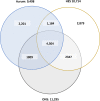Validation of the recording of idiopathic pulmonary fibrosis in routinely collected electronic healthcare records in England
- PMID: 37434192
- PMCID: PMC10337174
- DOI: 10.1186/s12890-023-02550-0
Validation of the recording of idiopathic pulmonary fibrosis in routinely collected electronic healthcare records in England
Abstract
Background: Routinely-collected healthcare data provide a valuable resource for epidemiological research. Validation studies have shown that for most conditions, simple lists of clinical codes can reliably be used for case finding in primary care, however, studies exploring the robustness of this approach are lacking for diseases such as idiopathic pulmonary fibrosis (IPF) which are largely managed in secondary care.
Method: Using the UK's Clinical Practice Research Datalink (CPRD) Aurum dataset, which comprises patient-level primary care records linked to national hospital admissions and cause-of-death data, we compared the positive predictive value (PPV) of eight diagnostic algorithms. Algorithms were developed based on the literature and IPF diagnostic guidelines using combinations of clinical codes in primary and secondary care (SNOMED-CT or ICD-10) with/without additional information. The positive predictive value (PPV) was estimated for each algorithm using the death record as the gold standard. Utilization of the reviewed codes across the study period was observed to evaluate any change in coding practices over time.
Result: A total of 17,559 individuals had a least one record indicative of IPF in one or more of our three linked datasets between 2008 and 2018. The PPV of case-finding algorithms based on clinical codes alone ranged from 64.4% (95%CI:63.3-65.3) for a "broad" codeset to 74.9% (95%CI:72.8-76.9) for a "narrow" codeset comprising highly-specific codes. Adding confirmatory evidence, such as a CT scan, increased the PPV of our narrow code-based algorithm to 79.2% (95%CI:76.4-81.8) but reduced the sensitivity to under 10%. Adding evidence of hospitalisation to the standalone code-based algorithms also improved PPV, (PPV = 78.4 vs. 64.4%; sensitivity = 53.5% vs. 38.1%). IPF coding practices changed over time, with the increased use of specific IPF codes.
Conclusion: High diagnostic validity was achieved by using a restricted set of IPF codes. While adding confirmatory evidence increased diagnostic accuracy, the benefits of this approach need to be weighed against the inevitable loss of sample size and convenience. We would recommend use of an algorithm based on a broader IPF code set coupled with evidence of hospitalisation.
Keywords: CPRD; Diagnostic codes; HES; Idiopathic pulmonary fibrosis; Interstitial lung disease; Pulmonary fibrosis; Validation.
© 2023. The Author(s).
Conflict of interest statement
RG is a current employee of Gilead Sciences, outside the submitted work. JKQ has received grants from The Health Foundation, MRC, GSK, Bayer, BI, British Lung Foundation, IQVIA, Chiesi AZ, Insmed and Asthma UK. JKQ has received personal fees for advisory board participation or speaking fees from GlaxoSmithKline, Boehringer Ingelheim, AstraZeneca, Bayer and Insmed. PMG has received grants from the MRC, Boehringer Ingelheim and Roche Pharmaceuticals and personal fees from Boehringer Ingelheim, Roche Pharmaceuticals, Teva, Cippla, AZ and Brainomix. AM has nothing to disclose.
Figures


Similar articles
-
Idiopathic Pulmonary Fibrosis in United States Automated Claims. Incidence, Prevalence, and Algorithm Validation.Am J Respir Crit Care Med. 2015 Nov 15;192(10):1200-7. doi: 10.1164/rccm.201504-0818OC. Am J Respir Crit Care Med. 2015. PMID: 26241562
-
Validation study of bullous pemphigoid and pemphigus vulgaris recording in routinely collected electronic primary healthcare records in England.BMJ Open. 2020 Jul 14;10(7):e035934. doi: 10.1136/bmjopen-2019-035934. BMJ Open. 2020. PMID: 32665386 Free PMC article.
-
Code-based Diagnostic Algorithms for Idiopathic Pulmonary Fibrosis. Case Validation and Improvement.Ann Am Thorac Soc. 2017 Jun;14(6):880-887. doi: 10.1513/AnnalsATS.201610-764OC. Ann Am Thorac Soc. 2017. PMID: 28355518 Free PMC article.
-
Identifying Parkinson's disease and parkinsonism cases using routinely collected healthcare data: A systematic review.PLoS One. 2019 Jan 31;14(1):e0198736. doi: 10.1371/journal.pone.0198736. eCollection 2019. PLoS One. 2019. PMID: 30703084 Free PMC article.
-
The accuracy of using administrative healthcare data to identify epilepsy cases: A systematic review of validation studies.Epilepsia. 2020 Jul;61(7):1319-1335. doi: 10.1111/epi.16547. Epub 2020 May 31. Epilepsia. 2020. PMID: 32474909
Cited by
-
Commonly prescribed medications and risk of pneumonia and all-cause mortality in people with idiopathic pulmonary fibrosis: a UK population-based cohort study.Pneumonia (Nathan). 2025 Jan 25;17(1):2. doi: 10.1186/s41479-024-00155-7. Pneumonia (Nathan). 2025. PMID: 39856755 Free PMC article.
-
Incidence and prevalence of asthma, chronic obstructive pulmonary disease and interstitial lung disease between 2004 and 2023: harmonised analyses of longitudinal cohorts across England, Wales, South-East Scotland and Northern Ireland.Thorax. 2025 Jun 16;80(7):466-477. doi: 10.1136/thorax-2024-222699. Thorax. 2025. PMID: 40199588 Free PMC article.
-
Mortality trends in idiopathic pulmonary fibrosis in Europe between 2013 and 2018.Eur Respir J. 2024 Aug 22;64(2):2302080. doi: 10.1183/13993003.02080-2023. Print 2024 Aug. Eur Respir J. 2024. PMID: 38871377 Free PMC article.
-
Incidence and survival of interstitial lung diseases in the UK in 2010-2019.ERJ Open Res. 2025 Mar 3;11(2):00823-2024. doi: 10.1183/23120541.00823-2024. eCollection 2025 Mar. ERJ Open Res. 2025. PMID: 40040895 Free PMC article.
-
A Harmonised Approach to Curating Research-Ready Datasets for Asthma, Chronic Obstructive Pulmonary Disease (COPD) and Interstitial Lung Disease (ILD) in England, Wales and Scotland Using Clinical Practice Research Datalink (CPRD), Secure Anonymised Information Linkage (SAIL) Databank and DataLoch.Clin Epidemiol. 2024 Apr 4;16:235-247. doi: 10.2147/CLEP.S437937. eCollection 2024. Clin Epidemiol. 2024. PMID: 38595770 Free PMC article.
References
-
- Raghu G, Collard HR, Egan JJ, Martinez FJ, Behr J, Brown KK, ATS/ERS/JRS/ALAT Committee on Idiopathic Pulmonary Fibrosis et al. An official ATS/ERS/JRS/ALAT statement: idiopathic pulmonary fibrosis: evidence-based guidelines for diagnosis and management. Am J Respir Crit Care Med. 2011;183(6):788–824. doi: 10.1164/rccm.2009-040GL. - DOI - PMC - PubMed
-
- King TE, Jr, Albera C, Bradford WZ, Costabel U, du Bois RM, Leff JA, et al. All-cause mortality rate in patients with idiopathic pulmonary fibrosis. Implications for the design and execution of clinical trials. Am J Respir Crit Care Med. 2014;189(7):825–31. doi: 10.1164/rccm.201311-1951OC. - DOI - PubMed
MeSH terms
LinkOut - more resources
Full Text Sources

